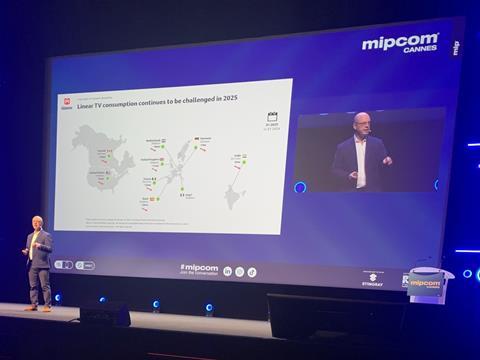Ratings institute Médiamétrie’s Glance details shifting viewing habits in annual Mipcom panel
The US and France are among countries that have experienced the biggest linear viewing declines over the first six months of the year, according to Glance, the international subsidiary of ratings institute Médiamétrie.

Frédéric Vaulpré, senior vice president of Glance, said theindustry was shifting to “a world of hyper-distribution to capture viewership” as he introduced his organisation’s findings here at Mipcom.
According to the consolidated data compiled by Glance from each country’s respective audience measurement organisations, the US, Germany, France, and Canada recorded the biggest drops in the first half of 2025.
Linear TV lost a hefty 16 minutes in the US, falling to a total watch time of 2 hours and 9 minutes daily.
In Germany and France, linear TV viewing was down by 14 and 13 minutes, respectively. The two countries, however, remain among those where linear TV is the strongest, with an average of two hours and 47 minutes in France and two hours and 42 minutes for Germany, behind Spain, which was down 10 minutes to two hours and 28 minutes.
The UK and the Netherlands respectively lost 11 and 10 minutes, falling to two hours and nine minutes and two hours, while Canada was down 13 minutes to two hours and seven minutes. India was down by just by three minutes to two hours and 17 minutes.
Streaming up
Streaming has been gaining ground, added Vaulpré. He gave the US as an example, where in May this year, the audience share of the networks and cable channels together fell for the first time below that of the streaming platforms.
The latter reached a peak of 47% in July (traditionally a weaker month for traditional TV), up from 28% four years before.
Streaming is also growing outside the US, although at a different pace. Glance said services reached a 35% share in the UK in July, up from 32% three years before, and 25% in Italy, compared to 15% in January 2023.
Among streaming platforms, YouTube and Netflix are by far the two leaders. In two years, YouTube doubled its US audience share, reaching 13%, and in the UK it rose to 16%, in both cases ahead of Netflix, which stands at 9% in the two countries. YouTube’s share is even bigger in Brazil (20%), Vaulpré pointed out.
Broadcasters’ BVoD platforms are also continuing to grow and bringing in a younger audience profile, Vaulpré said. While BBC linear viewing comprises 22% of 16-to-34-year-olds consumption, the same demo makes up 48% of BBC iPlayer consumption.
But broadcasters are also striking more partnerships with digital players as they look for additional younger audiences, he pointed out, mentioning deals between broadcasters and YouTube, and this summer’s TF1-Netflix distribution agreement.
Sports is a perfect example of hyper-distribution, he added. In the US, sports has traditionally been network and cable fare but it has increasingly shifted to SVoD platforms and there are now platforms looking to aggregate all of the above. “Everyone is discussing with everyone, including with competitors,” he concluded.








No comments yet